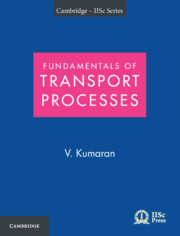Book contents
Summary
The momentum flux or the force per unit area on a surface within a fluid can be separated into two components: the pressure and the shear stress. The latter is due to variations in the flow velocity, while the former is present even when there is no flow. Pressure has no analogue in mass and heat transfer, where the fluxes are entirely due to the variations in the concentration/temperature fields. The fluid pressure is the compressive force per unit area exerted on a surface within the fluid in the direction perpendicular to the surface. At a point within the fluid, the pressure is a scalar which is independent of the orientation of the surface; the direction of the force exerted due to the pressure is along the perpendicular to the surface.
There is a distinction between the thermodynamic pressure and the dynamical pressure that drives fluid flow. The thermodynamic pressure is an absolute pressure which is calculated, for example, using the ideal gas equation of state. In contrast, flow is driven by the pressure difference between two locations in an incompressible flow. The velocity field depends on the variations in the dynamical pressure, and the flow field is unchanged if a constant pressure is added everywhere in the domain for an incompressible flow.
A potential flow is a limiting case of a pressure-driven flow where viscous effects are neglected. Some applications of potential flows are first reviewed in Section 6.1. The velocity profile and the friction factor for the laminar flow in a pipe is derived in Section 6.2. As discussed in Chapter 2, there is a transition from a laminar to a turbulent flow when the Reynolds number exceeds a critical value. The salient features of a turbulent flow are discussed in Section 6.3. The oscillatory flow in a pipe due to a sinusoidal pressure variation across the ends is considered in Section 6.4. This flow is used to illustrate the use of complex variables for oscillatory flows, and the approximations and analytical techniques used in the convection-dominated and diffusion-dominated regimes.
Potential Flow: The Bernoulli Equation
At high Reynolds number, viscous effects are neglected in the bulk of the flow, and there is a balance between the pressure, inertial and body forces.
- Type
- Chapter
- Information
- Fundamentals of Transport Processes with Applications , pp. 271 - 318Publisher: Cambridge University PressPrint publication year: 2023



